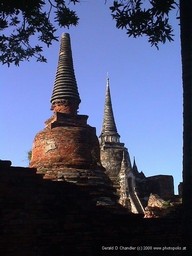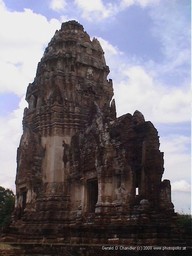Home | Front Page | Blog | Index | New | Contact | Site Map
Ban Sang & Phayao
Poang Salam, Wawi
Chiang Mai
Countryside by Car
Bangkok
Khao Yai NP
Khmer Temples
Ayutthaya
Ancient Capitals
Guest Houses
Medical Care
Foto Show
Other Thailand

Cambodia 2001
China 1999
China 2000
China 2001
Hong Kong 1999
Hong Kong 2000
Laos2001
Thailand 2000
Thailand 2001
Vietnam 2000
Vietnam 2001
Britain 1999
Britain 2000
Britain 2001

Lanna Temple at Chiang Mai
|

Sukhothai Temple at Ayutthaya |

Khmer temple at Lopburi |
Most visitors come to Thailand for the palm-fringed beaches, clear limpid water, endless sunshine, and fiery food. For the hardy, however, there is another side to this “Land of Smiles”, as the Thai proudly describe themselves. Thailand is also a land of many capitals. Its northern regions encompass no fewer than three former capitals of the kingdom of Lanna. The center of the country is the site of Sukhothai, the capital of the kingdom of Sukhothai. And finally, the region north of Bangkok is home to the two ancient Siamese capitals of Lopburi and Ayutthaya.
The number of capitals attests to the turbulence of the region’s history and the gradual movement of the center of power from the north to the Gulf of Thailand through centuries of war with neighbouring countries. The varied architecture of these capitals bear witness to the number of empires that held sway over its land. Here you find, Lanna and Lao, Khmer and Burmese, all intermixed with ancient Siamese styles.
Our first encounter was with the ruined city of Sukhothai, now a national park not far from the city of Phitsanulok. There in December 2000, we found the ruins of a whole collection of temples and stupas and statues of Buddha set amidst a vast park of lakes and lawns. We spent several hours wandering through these remnants of what to us was a relatively unknown civilization in an area of the world whose history was unfamiliar to us. We were most effected by the stark beauty of these red brick structures against the green grass and the rather exotic shapes formed by stupa spires and headless seated buddhas against the rich colours of the bougainvillea and frangipani blossoms. We reflected little at that time on the course of history that left this legacy.
The visit to Sukhothai was followed closely by a trip to Chiang Mai, the third in time of three capitals of the Lanna kingdom. No ruined city this, it is a vibrant and much-visited provincial capital. But scattered among its streets and canals are many temples built by the Lanna rulers and their Burmese rivals. Here we were impressed by the beauty of temples both ancient and modern, but did not yet grasp the connections between the kingdoms of Lanna and Sukkothai nor their connection to the present. To make an analogy with learning a new language, we had the beginnings of a new vocabulary but we had no inkling of its grammar.
The history of Thailand did not start to come into focus until many months later after visits to Vietnam, Laos, and Cambodia, and after two more visits to Thailand itself. In Laos in particular we learned much more about the Thai/Lao ethnic group that straddles the Mekong river and covers parts of northern Laos and northern Thailand. Our first hints came when we recognized in Lao temples many features similar to those of the temples we had seen in Chiang Mai. Our vocabulary was widening and deepening. As we learned the history of Laos, we found out how much of it was intertwined with the history of Northern Thailand. The languages of Laos and Thailand have much in common; the art and architecture of their religious and royal buildings share a common heritage.
More pieces of the history puzzle fell into place when we left Laos and crossed into Northern Thailand and visited the earliest ancient Lanna capital of Chiang Saen, now a small town near the Golden Triangle where Burma, Thailand, and Laos come together, that is dotted with the ruins of ancient stupas that mark the beginning of the Kingdom of a thousand elephants. Armed with this new knowledge we moved on to the second Lanna capital, Chiang Rai, now a popular tourist destination and provincial capital. And finally we came full circle to Chiang Mai, the third and last Lanna capital on current Thai soil. It was here that we found another missing piece: the Lanna kingdom was absorbed by its more powerful neighbor to the south — Sukhothai. We now had a clearer sense of the history of Northern Thailand, its relationship to Laos to the east, and its rivalry with Burmese kingdoms to the north and west. We were starting to pick up the rudiments of grammar.
From the north, we switched our attention to the eastern provinces of Thailand and the area bordering on Cambodia. Here we found remnants of long-dead Khmer empires that believed in Indian gods. For these Indian gods, the Khmer rulers built Indianised temples, the most famous of which is of course Angkor Wat. But until we contemplated visiting Cambodia, we had no idea that the empire that built Angkor Wat extended into Thailand and left its mark in the lovely temples of Phimai and Phnom Rung.
In the ten days we spent in and around Angkor Wat in Cambodia we learned about the long line of Khmer rulers who built temples in the Angkor region to celebrate the expansions of their Empire and the result of battle with the neighboring areas of Thailand.
Finally, in Thailand for a fourth time, we took the train north from Bangkok and visited the two ancient capitals of Ayutthaya and Lopburi where we found the last pieces needed to link the past to the present. Lopburi’s remains showed clear evidence that the city had been part of the Khmer empire before it was established as the capital of a Siamese kingdom. We immediately recognised the Khmer-style towers called prangs that grace ancient Lopburi’s temples. The remains in Ayutthaya, although they also had Khmer influence, were more varied including Sukkhothai influences on the spirals of stupa spires and even some echoes of Chiang Saen.
So, over a period of nine months we had gone from total ignorance of the history of this part of southeast asia to a grasp not only of the outlines of that history but more importantly of the art and architecture that tells its story. Now all that remains is for us to fill in the missing piece — the Burmese. Maybe next year.